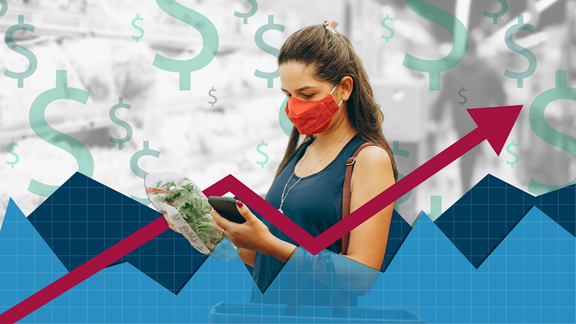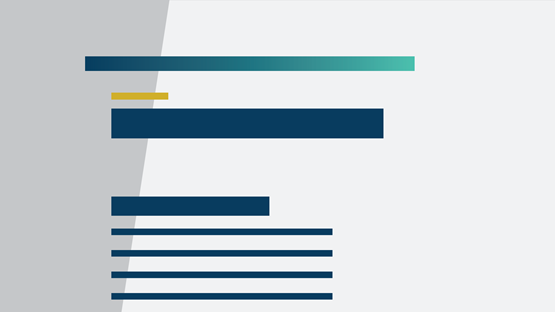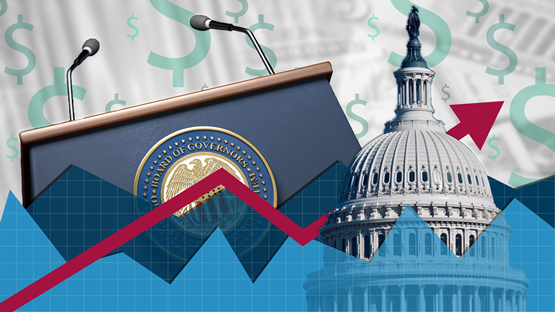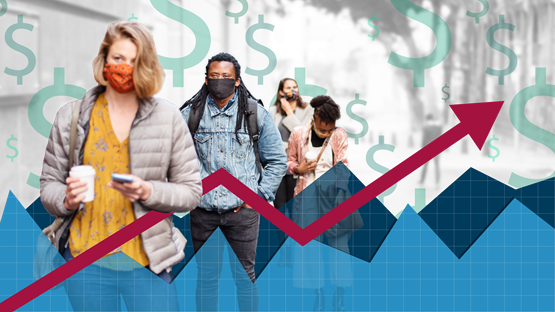Roughly ten of ten economists would agree: Inflation is bad news. Prices rise, eroding the purchasing power of the money in your pocket and your hard-earned savings. There’s a friction added to every financial decision, as we try to predict the future.
Unlike unemployment, inflation touches every person, nearly every day. While inflation can generate temporary pockets of winners—notably, people who have borrowed money at a fixed interest rate—economists generally agree that as a society, we are better off without it (or with just enough to stave off deflation).
From there, though, the questions get harder. Just how harmful is inflation to our economic well-being? Is it worse for some than others? When is the cure worse than the disease?
At the Minneapolis Fed, Senior Research Economist Juan Pablo Nicolini is advancing the long-running pursuit by economists of that first question: How do we measure the total cost of inflation to society?
The topic holds an academic fascination, but for Nicolini, inflation has always been a little bit personal. “I’m from Argentina—that should explain it,” he said. During the 1980s, while Nicolini was pursuing his economics degrees, he says annual inflation in his home country varied between 200 percent and 2,000 percent.
The U.S. is no Argentina, of course. And Nicolini is careful to stress that his gaze is fixed firmly on the long run, not the month-to-month bumps that drive today’s headlines.1
With that caveat in mind, his work finds that even at historically moderate levels, inflation steadily erodes our well-being. Economists typically measure such costs to society—known as “welfare costs”—in terms of sacrificed consumption over an average person’s lifetime. In a recent Minneapolis Fed working paper Nicolini and economist Luca Benati2 find a long-term inflation rate of 5 percent comes at a cost potentially more than 1 percent of the lifetime consumption of every American. The estimated loss is higher for countries that are more cash dependent.
“That’s a huge number,” Nicolini said. “As economists, we typically think that if something could improve things to the point of saving you 1 percent of your consumption, that’s something really worth pursuing.” Nicolini likens that figure to roughly 5 percent of U.S. government spending. Imagine what more a country might spend on education, he says—thereby investing in further economic growth—if it weren’t losing that to inflation.
Inflation does its damage by distorting incentives, keeping the economy from reaching optimal outcomes. It acts as a tax on money, one of the fundamental innovations of capitalism. By making money less efficient, it disrupts trade, the essence of a market economy. Nicolini’s research shows that sustained inflation of 5 percent can entail significant costs.
Nicolini reflects the widespread belief among economists that while we all pay in the end, the incidence of inflation tends to be regressive: “The higher you go with inflation, the more you are putting the cost on the lower-income population,” he said.
Long legacy, ongoing debate
As a matter of mathematics, the approach of Benati and Nicolini involves calculating the area under the “money demand curve,” the plotted relationship between the nominal interest rate and the quantity of money in a nation’s economy. As the interest rate (a proxy for inflation) rises, the demand for money falls, triggering changes in spending, saving, investment, government financing—you name it. There’s not much in the economy left untouched by the price and value of money.
While the basic concept of integrating under a curve is Calculus 101, this approach has been refined and debated by scholars over more than 50 years, tracing a lineage back through Nobel laureates Robert Lucas and Milton Friedman, arguably to a 1956 paper by Martin J. Bailey. The findings have oscillated with new ideas, more data, and alternate models. Provocative work published in the American Economic Review in 2009 by Boston College economist Peter Ireland, for example, proposed that advanced economies have become much less reliant on traditional forms of money, an assumption that leads to estimates of the cost of inflation that are “quite small,” in the paper’s own words.
Benati and Nicolini swing the pendulum back. They make the case that modern economies are far from moneyless, or immune from the harmful effects of inflation. They advance the field by plotting the curves for 11 advanced economies, and by including in their model the potential for nominal interest rates to go below zero—a phenomenon virtually unseen before 2010, but lately a fact of life in Sweden, Switzerland, and the Eurozone. By widening their data beyond the U.S., they find that the same level of inflation does less harm in Japan, and generally more harm Europe. The U.S. is in the middle of the pack.
“Some countries, for reasons we still don’t understand well, tend to be much more cash intensive,” Nicolini said. Banking systems and practices vary, as do cultural preferences for conducting transactions with cash; it could even matter how often people get their paychecks. “Some societies are more money intensive than others, and inflation is like a tax on money. The more you use, the more expensive is the tax.”
Keeping the headlines in perspective
The friendly competition by Nicolini and others to pin down the long-term cost of inflation speaks to our present moment—though in a highly nuanced way.
“This literature has the long run in mind: How costly is the inflation target you choose? That’s an issue you’re going to have for decades,” Nicolini said. “Everybody would agree that it is best to have low inflation in the long run. How much to deviate from that, at a given point in time—that is a different sort of debate.”
Amid the breathless, blow-by-blow news coverage and speculation about tapering, “ramp-ups,” and “liftoffs,” the welfare-cost-of-inflation research is a reminder not to unduly sweat the short term. Nicolini and Benati measure notable costs when inflation runs at more than 5 percent on average, over many years. But short-term spikes into that range—like we have seen as we emerge from the pandemic—are very different.
“Monetary policy is not an exact science,” Nicolini said. “It has been very precise and efficient in the past decade, but it’s not always going to be easy to get the target exactly or to get quickly back to the target. We’re going to have swings.”
The Fed’s monetary policy strategy is constructed to target a low (2 percent) inflation rate on average, over time—not to quickly stamp out every bump in the path. From the perspective of this welfare-cost school of research, the long run is where we do ourselves serious harm. Short-term changes in inflation are natural and inevitable.
The big benefit of (a little) inflation
If inflation imposes a long-term cost, why not aim for a long-run rate of zero?
First, the benefits of driving inflation down even further from already-low levels appear to be small. “The (welfare) difference between 1 and 2 percent inflation is not that large, as we compute in the paper,” Nicolini said.
In a 2004 paper by economists James Bullard (now president of the St. Louis Fed) and Steven Russell, they find dramatic welfare costs at higher levels of inflation but caution against efforts to drive inflation below 2.5 percent. (Read our Q&A with President Bullard about his work in his area and how it informs him as a policymaker.)
“Further reductions in the inflation rate for the U.S. economy are likely to be both much more difficult to achieve, and much less beneficial if achieved, than the reductions that have taken place since the early 1980s,” they write. At very low levels of inflation, they posit, governments would need to raise taxes to cover the nominal revenue they lose as inflation falls. (Inflation tends to benefit borrowers, and the government is the biggest borrower around.)
But one of the biggest benefits to sustaining low—but definitely non-zero—inflation is avoiding deflation. “It’s like having a little bit of a cushion,” said Nicolini, as short-term inflation trends naturally swing around the target rate. “There is an asymmetry there—a little deflation is much worse than a little inflation.”
In a deflationary environment, consumers delay spending in expectation of lower prices later. Entrepreneurs, homeowners, and others who borrow money to make investments see those debts grow in real terms. All this holding-off has a nasty effect on economic activity, and monetary tools may be powerless to reverse course. Just ask the Japanese, where deflation (and the ensuing deflationary mindset it left in its wake) were among the culprits in the “lost decade” of 1991-2001 and tepid growth that continues to this day.
Somewhere between the distorting effects of inflation and the desire to keep deflation at arm’s length is a target level of inflation—or a band, as in New Zealand—that central banks can choose, based upon ongoing research like Nicolini’s (among many other inputs).
While some Fed economists continue their pursuit of the wide view of the cost of inflation to society, others have zoomed in tightly on the household inflation experience—the subject of a forthcoming article.
Endnotes
1 Neither this article nor the research cited necessarily reflects the views of the Federal Reserve Bank of Minneapolis or the Federal Reserve System.
2 University of Bern
Jeff Horwich is the senior economics writer for the Minneapolis Fed. He has been an economic journalist with public radio, commissioned examiner for the Consumer Financial Protection Bureau, and director of policy and communications for the Minneapolis Public Housing Authority. He received his master’s degree in applied economics from the University of Minnesota.





